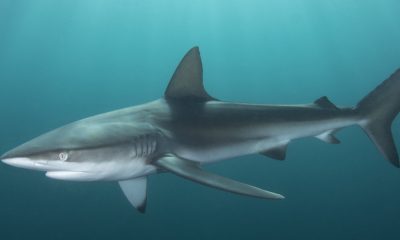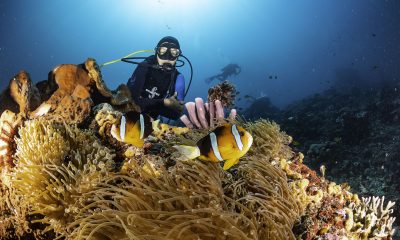News
Diving with the Ocean Sunfish or Mola Mola

Each year, between August and November, the Ocean Sunfish or Mola Mola come to the clean, clear waters off the East Coast of Bali near the island of Nusa Penida to be cleaned and groomed.
Diving with them gives you the adrenaline rush of diving with Great Whites in the Cape but without the protection of a cage. However, the danger comes not from the fish but from the sea itself.
These are volcanic islands, and the sea bed is often hundreds of metres below. The cleaner stations are in Crystal Bay and Manta Point, which are both subject to tidal fluctuations and unpredictable current changes, with vertical walls where the swirling currents can drag a diver down before he can react. To dive there at all you should always take an experienced guide. This is diving at its most unpredictable, and all the early diver training skills come into play. This is where things can go wrong and you have to be very aware of the dangers.
As always with diving, nobody can guarantee a sighting of anything in nature. In Mola Mola season the whole Balinese diving community is focused on the sightings. The sunfish don’t always come and only the best dive guides can predict with any certainty where they will be. Factors that play a role are tides, currents and of course the unpredictable whimsy of large marine animals.
The sea was rough, and we only kitted up once we had arrived at Nusa Penida. There we were given a full briefing on how to behave around the Mola Mola. I felt heavily over-weighted, as though I had an extra 5kg on my weight belt, and inflated my BC a little. Then I realized it was not weight, it was current, and the downward pull was so strong that I had to fin like hell just to stay in one place. At last we reached the cleaner station, and there he was, massive, primitive, his vestigial tail already being picked at by banner fish. Our first Mola Mola.

I slowly circled round the animal, filming as I went. Once I had reached the other side of him the cameras kicked in and the water was filled with photographers with their apertures wide open and their shutter speeds on slow… taking hundreds of pictures of this amazing creature.
He obligingly hung for 12 minutes while all around him the cameras went ballistic, bony mouth half open, hard round tongue visible, gulping and gasping with his huge round eyes staring into the deep, apparently oblivious of the divers all around him. The banner fish swarmed around him, picking off parasites, burrowing into wounds, sucking up the debris. Then he seemed to get bored, turned his back on us and with a leisurely flick of his fins, vanished into the distance.
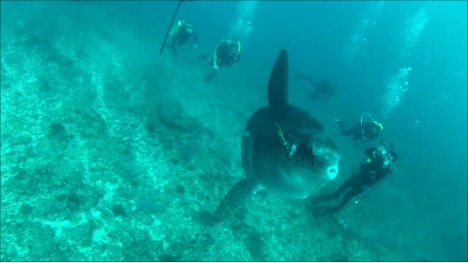
In the days that followed we explored several more dive sites fruitlessly looking for another Sunfish, and our persistence was eventually rewarded.
We could not even enter Crystal Bay as the tide was low, the currents dangerously unpredictable, and Parman felt we should try Manta Point again; at least we could look at the pelagic mantas if nothing else.
This time we were alone, there were no other photographers, and we had no expectation of seeing anything, when suddenly out of the misty blue a Mola Mola arrived, totally unselfconscious, posing for photography… and then another arrived, also relaxed, ready for a grooming.
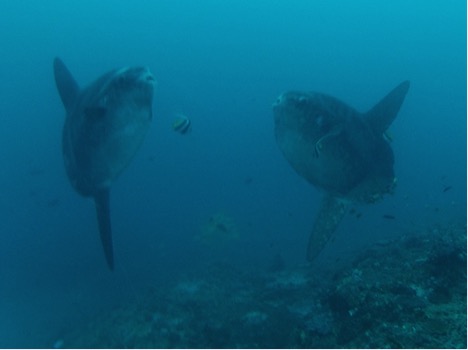
The Ocean Sunfish are bony fish, with large lateral fins like a whale, but they hang vertically in water like blaasops, and they used to be classified scientifically as Molidae until fairly recently.
Viewed side on, they are huge, like oval elephants, but from behind they are almost 2 dimensional, like a playing card. They seem to get a lot of parasites in their vestigial tails, which are not actually tails at all, but in fact a fusion of their dorsal and anal fins to make a sort of rudder, called a caudus. This is flat, rounded and scalloped, a bit like pie crust. There are 12 fin rays in the caudus and it is here that the parasites lodge. It is because of this that Mola Mola need help at cleaner stations.
They are by far the world’s most prolific egg laying fish. Their eggs scatter over vast areas, and the baby sunfish look a little like puffer fish, and bear little resemblance to their bizarre parents in their early years. They are born with a tail fin, which eventually fuses with maturity and have all the normal bony spines characteristic of the puffer fish or blaasop. They swim in schools to start with, only becoming solitary as they reach sexual maturity.
The adults are huge animals, growing up to 3 metres across and weighing around a ton, making them the largest bony fish in the ocean.
So how do they sustain this huge bulk? They mainly eat jelly fish, plankton, small fish and zooplankton. When you compare the small round mouth of the Mola Mola with the massive mouth of a whale shark, they must spend most of their time trying to ingest enough food to sustain this bulk. They suck water and food in through the mouth and their teeth have fused into a beak-like structure, while they have crushing teeth at the back of the throat that enable them to tear crustateans into smaller bits.
Speculation is that they are extremely vulnerable to the cold, as they are sometimes seen lying near the surface on their sides looking dead. The scientists think this is to expose as much of their bulk as possible to the sun and certainly they cannot survive cold oceans, preferring temperatures of over 10 degrees. This makes finding enough food difficult, as zoo plankton and jellies mainly occur where there is a cold upwelling or current flooding in from the colder depths of the ocean. To obtain sufficient food it is thought they may also have to dive down to great depths, as side-catch Mola Mola deaths have revealed stomach contents from vegetation and shrimps living at depths below 200 metres. Their cumbersome structure makes travel fairly slow and by swishing the dorsal and ventral fins they can only travel at a rate of up to 26 km a day.
Diving with this animal was an absolute revelation and a huge privilege. It was really worth the long flight, the tedious hours waiting for planes, the interminable boat rides, braving the dangerous currents and staying calm when all the early diver training was tested to its limit, but I’d do it again in a heartbeat.
Words: Jill Holloway
Pics: David Holloway
Copyright: Ocean Spirit
News
Dive Worldwide Announces Bite-Back as its Charity of the Year

Over the next 12 months, specialist scuba holiday company Dive Worldwide will be supporting Bite-Back Shark & Marine Conservation with donations collected from client bookings to any one of its stunning dive destinations around the world. The independently-owned operator expects to raise £3000 for the UK charity.
Manager at Dive Worldwide, Phil North, said: “We’re especially excited to work with Bite-Back and support its intelligent, creative and results-driven campaigns to end the UK trade in shark products and prompt a change in attitudes to the ocean’s most maligned inhabitant.”
Bite-Back is running campaigns to hold the media to account on the way it reports shark news along with a brand new nationwide education programme. Last year the charity was credited for spearheading a UK ban on the import and export of shark fins.
Campaign director at Bite-Back, Graham Buckingham, said: “We’re enormously grateful to Dive Worldwide for choosing to support Bite-Back. The company’s commitment to conservation helps set it apart from other tour operators and we’re certain its clients admire and respect that policy. For us, the affiliation is huge and helps us look to the future with confidence we can deliver against key conservation programmes.”
To launch the fundraising initiative, Phil North presented Graham Buckingham with a cheque for £1,000.
Visit Dive Worldwide to discover its diverse range of international scuba adventures and visit Bite-Back to learn more about the charity’s campaigns.
MORE INFORMATION
Call Graham Buckingham on 07810 454 266 or email graham@bite-back.com
Gear News
Scubapro Free Octopus Promotion 2024
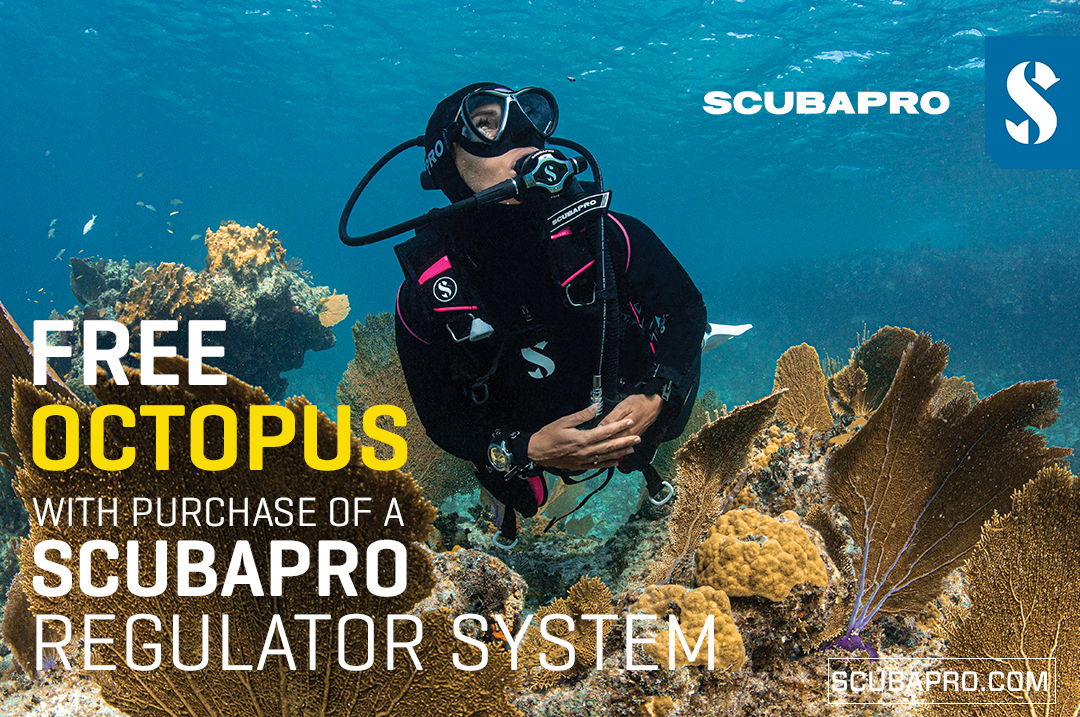
Free Octopus with every purchase of a SCUBAPRO regulator system
Just in time for the spring season, divers can save money with the FREE OCTOPUS SPRING PROMOTION! Until July 31st SCUBAPRO offers an Octopus for free
with every purchase of a regulator system!
Get a free S270 OCTOPUS with purchase of these combinations:
MK25 EVO or MK19 EVO with A700
MK25 EVO or MK19 EVO with S620Ti
MK25 EVO or MK19 EVO with D420
MK25 EVO Din mit S620Ti-X
Get a free R105 OCTOPUS with purchase of the following combinations:
MK25 EVO or MK19 EVO with G260
MK25 EVO or MK17 EVO with S600
SCUBAPRO offers a 30-year first owner warranty on all regulators, with a revision period of two years or 100 dives. All SCUBAPRO regulators are of course certified according to the new European test standard EN250-2014.
Available at participating SCUBAPRO dealers. Promotion may not be available in all regions. Find an authorized SCUBAPRO Dealer at scubapro.com.
More information available on www.scubapro.com.
-

 News3 months ago
News3 months agoHone your underwater photography skills with Alphamarine Photography at Red Sea Diving Safari in March
-

 News3 months ago
News3 months agoCapturing Critters in Lembeh Underwater Photography Workshop 2024: Event Roundup
-

 Marine Life & Conservation Blogs3 months ago
Marine Life & Conservation Blogs3 months agoCreature Feature: Swell Sharks
-

 Blogs2 months ago
Blogs2 months agoMurex Resorts: Passport to Paradise!
-

 Blogs2 months ago
Blogs2 months agoDiver Discovering Whale Skeletons Beneath Ice Judged World’s Best Underwater Photograph
-

 Gear Reviews2 weeks ago
Gear Reviews2 weeks agoGEAR REVIEW – Revolutionising Diving Comfort: The Sharkskin T2 Chillproof Suit
-

 Marine Life & Conservation2 months ago
Marine Life & Conservation2 months agoSave the Manatee Club launches brand new webcams at Silver Springs State Park, Florida
-

 Gear Reviews3 months ago
Gear Reviews3 months agoGear Review: Oceanic+ Dive Housing for iPhone









